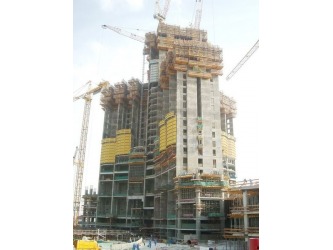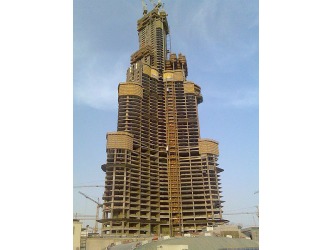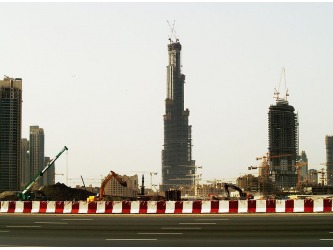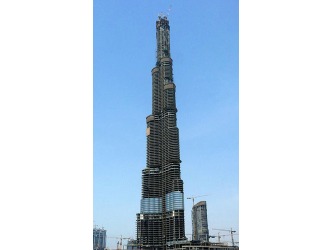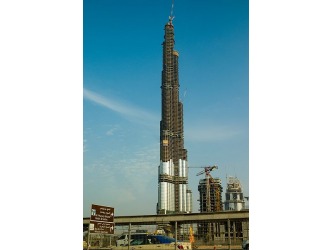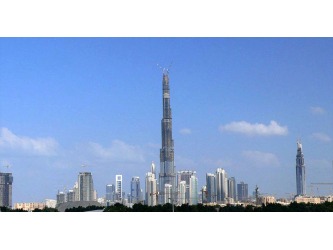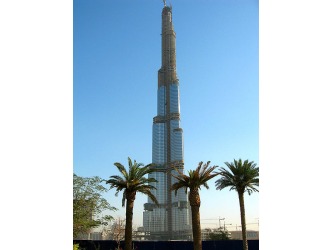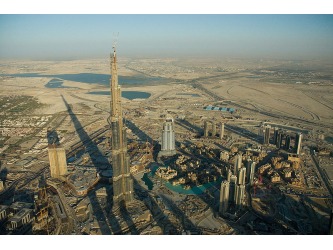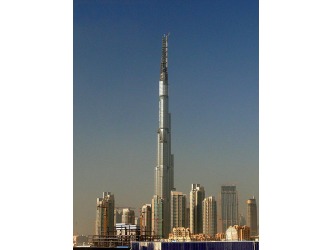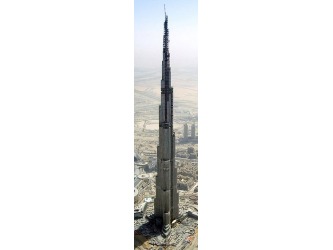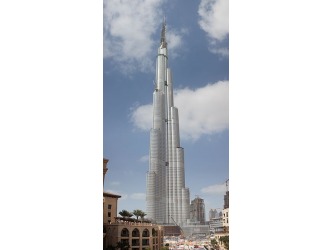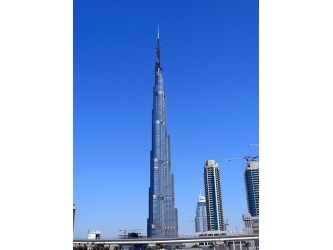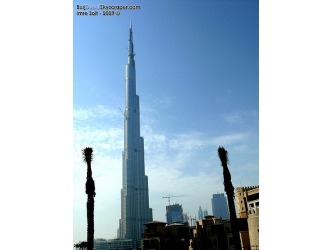Top Skyscrapers
Burj Dubai
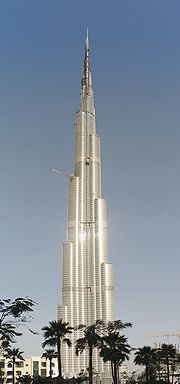
Burj Dubai (Arabic: برج دبي "Dubai Tower"), a supertall skyscraper under construction in Dubai,
United Arab Emirates, is the tallest man-made structure ever built, at 818 m (2,684 ft). Construction
began on 21 September 2004, and the tower is expected to be completed and ready for occupancy by the end
of 2009.
The building is part of the 2 km2 (0.8 sq mi) development called "Downtown Burj Dubai" at the "First
Interchange" along Sheikh Zayed Road at Financial Centre Road (previously known as Doha Street). The
tower's architect is Adrian Smith, who worked with Skidmore, Owings and Merrill (SOM) until 2006.
The Chicago-based architecture and engineering firm SOM is in charge of the project.The primary
builders are Samsung Engineering & Construction and Besix along with Arabtec. Turner Construction
Company was chosen as the construction manager.
The total budget for the Burj Dubai project is about US$4.1 billion, and for the entire new "Downtown Dubai",
US$20 billion.[11] Mohamed Ali Alabbar, the CEO of Emaar Properties, speaking at the Council on Tall Buildings
and Urban Habitat 8th World Congress, said that the price of office space at Burj Dubai had reached US$4,000
per sq ft (over US$43,000 per m2) and that the Armani Residences, also in Burj Dubai, were selling for US$3,500
per sq ft (over US$37,500 per m2).
United Arab Emirates, is the tallest man-made structure ever built, at 818 m (2,684 ft). Construction
began on 21 September 2004, and the tower is expected to be completed and ready for occupancy by the end
of 2009.
The building is part of the 2 km2 (0.8 sq mi) development called "Downtown Burj Dubai" at the "First
Interchange" along Sheikh Zayed Road at Financial Centre Road (previously known as Doha Street). The
tower's architect is Adrian Smith, who worked with Skidmore, Owings and Merrill (SOM) until 2006.
The Chicago-based architecture and engineering firm SOM is in charge of the project.The primary
builders are Samsung Engineering & Construction and Besix along with Arabtec. Turner Construction
Company was chosen as the construction manager.
The total budget for the Burj Dubai project is about US$4.1 billion, and for the entire new "Downtown Dubai",
US$20 billion.[11] Mohamed Ali Alabbar, the CEO of Emaar Properties, speaking at the Council on Tall Buildings
and Urban Habitat 8th World Congress, said that the price of office space at Burj Dubai had reached US$4,000
per sq ft (over US$43,000 per m2) and that the Armani Residences, also in Burj Dubai, were selling for US$3,500
per sq ft (over US$37,500 per m2).
Height
Timeline
* 21 September 2004: Emaar contractors begin construction.
* February 2007: Surpasses the Sears Tower (since renamed to the Willis Tower) as the building with the most floors.
* 13 May 2007: Sets record for vertical concrete pumping on any building at 452 m (1,483 ft), surpassing the 449.2 m (1,474 ft) to which concrete was pumped during the construction of Taipei 101.[13]
* 21 July 2007: Surpasses Taipei 101, whose height of 509.2 m (1,671 ft) made it the world’s tallest building.[14]
* 12 August 2007: Surpasses the Sears Tower (Willis Tower) antenna, which stands 527.3 m (1,730 ft).
* 3 September 2007: Becomes the second-tallest freestanding structure, surpassing the 540 m (1,772 ft) Ostankino Tower in Moscow.
* 12 September 2007: At 555.3 m (1,822 ft), becomes the world's tallest freestanding structure, surpassing the CN Tower in Toronto.[15]
* 7 April 2008: At 629 m (2,064 ft), surpasses the KVLY-TV Mast to become the tallest man-made structure.[16]
* 17 June 2008: Emaar announces that Burj Dubai's height is over 636 m (2,087 ft) and that its final height will not be given until it is completed in September 2009.[5]
* 1 September 2008: Height tops 688 m (2,257 ft), making it the tallest man-made structure ever built, surpassing the previous record-holder, the Warsaw Radio Mast in Konstantynów, Poland.[17]
* 17 January 2009: Topped out at 818 m (2,684 ft).
* 21 September 2004: Emaar contractors begin construction.
* February 2007: Surpasses the Sears Tower (since renamed to the Willis Tower) as the building with the most floors.
* 13 May 2007: Sets record for vertical concrete pumping on any building at 452 m (1,483 ft), surpassing the 449.2 m (1,474 ft) to which concrete was pumped during the construction of Taipei 101.[13]
* 21 July 2007: Surpasses Taipei 101, whose height of 509.2 m (1,671 ft) made it the world’s tallest building.[14]
* 12 August 2007: Surpasses the Sears Tower (Willis Tower) antenna, which stands 527.3 m (1,730 ft).
* 3 September 2007: Becomes the second-tallest freestanding structure, surpassing the 540 m (1,772 ft) Ostankino Tower in Moscow.
* 12 September 2007: At 555.3 m (1,822 ft), becomes the world's tallest freestanding structure, surpassing the CN Tower in Toronto.[15]
* 7 April 2008: At 629 m (2,064 ft), surpasses the KVLY-TV Mast to become the tallest man-made structure.[16]
* 17 June 2008: Emaar announces that Burj Dubai's height is over 636 m (2,087 ft) and that its final height will not be given until it is completed in September 2009.[5]
* 1 September 2008: Height tops 688 m (2,257 ft), making it the tallest man-made structure ever built, surpassing the previous record-holder, the Warsaw Radio Mast in Konstantynów, Poland.[17]
* 17 January 2009: Topped out at 818 m (2,684 ft).
Current records
* Tallest structure: 818 m (2,684 ft) (previously KVLY-TV mast - 628.8 m (2,063 ft))
* Tallest freestanding structure: 818 m (2,684 ft) (previously CN Tower - 553.3 m (1,815 ft))
* Building with most floors: 160 (previously Sears Tower (Willis Tower) / World Trade Center - 110)
* World's highest elevator installation
* Worlds fastest elevators at speed of 60 km/h or 16.7 m/s (55 ft/s)
* Highest vertical concrete pumping (for a building): 601 m (1,972 ft) (previously Taipei 101 - 449.2 m (1,474 ft))
* Highest vertical concrete pumping (for any construction): 601 m (1,972 ft) (previously Riva del Garda Hydroelectric Power Plant - 532 m (1,745 ft)
* First world's tallest structure in history that includes residential space.
Note: Additional records for tallest skyscraper are considered unofficial. On 20 July 2007, the head of the Council on Tall Buildings and Urban Habitat (CTBUH), Antony Wood, said "We will not classify it as a building until it is complete, clad and at least partially open for business to avoid things like the Ryungyong [sic] project. Taipei 101 is thus officially the world's tallest until that happens.
* Tallest freestanding structure: 818 m (2,684 ft) (previously CN Tower - 553.3 m (1,815 ft))
* Building with most floors: 160 (previously Sears Tower (Willis Tower) / World Trade Center - 110)
* World's highest elevator installation
* Worlds fastest elevators at speed of 60 km/h or 16.7 m/s (55 ft/s)
* Highest vertical concrete pumping (for a building): 601 m (1,972 ft) (previously Taipei 101 - 449.2 m (1,474 ft))
* Highest vertical concrete pumping (for any construction): 601 m (1,972 ft) (previously Riva del Garda Hydroelectric Power Plant - 532 m (1,745 ft)
* First world's tallest structure in history that includes residential space.
Note: Additional records for tallest skyscraper are considered unofficial. On 20 July 2007, the head of the Council on Tall Buildings and Urban Habitat (CTBUH), Antony Wood, said "We will not classify it as a building until it is complete, clad and at least partially open for business to avoid things like the Ryungyong [sic] project. Taipei 101 is thus officially the world's tallest until that happens.
Construction
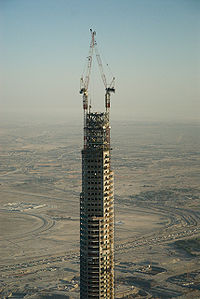
The tower is being constructed by a South Korean company, Samsung Engineering & Construction, which also built the Petronas Twin Towers and the Taipei 101.Samsung Engineering & Construction is building the tower in a joint venture with Besix from Belgium and Arabtec from UAE. Turner is the Project Manager on the main construction contract.
The primary structural system of Burj Dubai is reinforced concrete. Over 45,000 m3 (58,900 cu yd) of concrete, weighing more than 110,000 tonnes (120,000 ST; 110,000 LT) were used to construct the concrete and steel foundation, which features 192 piles buried more than 50 m (164 ft) deep. When completed, Burj Dubai's construction will have used 330,000 m3 (431,600 cu yd) of concrete and 39,000 tonnes (43,000 ST; 38,000 LT) of steel rebar, and construction will have taken 22 million man-hours.
As construction of the tower progresses, it becomes increasingly difficult to vertically pump the thousands of cubic metres of concrete that are required. The previous record for pumping concrete on any project was set during the extension of the Riva del Garda Hydroelectric Power Plant in Italy in 1994, when concrete was pumped to a height of 532 m (1,745 ft). Burj Dubai exceeded this height on 19 August 2007, and as of 8 November 2007 concrete was pumped to a delivery height of 601 m (1,972 ft).
Special mixes of concrete are made to withstand the extreme pressures of the massive weight of the tower; as is typical with reinforced concrete construction, each batch of concrete is tested and checked to see whether it can withstand certain pressures. The concrete pumps, pipelines and booms are provided by Putzmeister, of Aichtal, Germany.
The consistency of the concrete used in the project is essential. It was difficult to create a concrete that could withstand both the thousands of tonnes bearing down on it and Persian Gulf temperatures that can reach 50 °C (122 °F). To combat this problem, the concrete is not poured during the day. Instead, ice is added to the mixture and it is poured at night when it is cooler and the humidity is higher. A cooler concrete mixture cures evenly throughout and therefore is less likely to set too quickly and crack. Any significant cracks could put the whole project in jeopardy.
The unique design and engineering challenges of building Burj Dubai have been featured in a number of TV documentaries, including the Big, Bigger, Biggest series on the National Geographic and Five channels, and the Mega Builders series on the Discovery Channel.
The primary structural system of Burj Dubai is reinforced concrete. Over 45,000 m3 (58,900 cu yd) of concrete, weighing more than 110,000 tonnes (120,000 ST; 110,000 LT) were used to construct the concrete and steel foundation, which features 192 piles buried more than 50 m (164 ft) deep. When completed, Burj Dubai's construction will have used 330,000 m3 (431,600 cu yd) of concrete and 39,000 tonnes (43,000 ST; 38,000 LT) of steel rebar, and construction will have taken 22 million man-hours.
As construction of the tower progresses, it becomes increasingly difficult to vertically pump the thousands of cubic metres of concrete that are required. The previous record for pumping concrete on any project was set during the extension of the Riva del Garda Hydroelectric Power Plant in Italy in 1994, when concrete was pumped to a height of 532 m (1,745 ft). Burj Dubai exceeded this height on 19 August 2007, and as of 8 November 2007 concrete was pumped to a delivery height of 601 m (1,972 ft).
Special mixes of concrete are made to withstand the extreme pressures of the massive weight of the tower; as is typical with reinforced concrete construction, each batch of concrete is tested and checked to see whether it can withstand certain pressures. The concrete pumps, pipelines and booms are provided by Putzmeister, of Aichtal, Germany.
The consistency of the concrete used in the project is essential. It was difficult to create a concrete that could withstand both the thousands of tonnes bearing down on it and Persian Gulf temperatures that can reach 50 °C (122 °F). To combat this problem, the concrete is not poured during the day. Instead, ice is added to the mixture and it is poured at night when it is cooler and the humidity is higher. A cooler concrete mixture cures evenly throughout and therefore is less likely to set too quickly and crack. Any significant cracks could put the whole project in jeopardy.
The unique design and engineering challenges of building Burj Dubai have been featured in a number of TV documentaries, including the Big, Bigger, Biggest series on the National Geographic and Five channels, and the Mega Builders series on the Discovery Channel.
Purpose
Burj Dubai has been designed to be the centerpiece of a large-scale, mixed-use development that will include 30,000 homes, nine hotels such as the Burj Dubai Lake Hotel & Serviced Apartments, 3 hectares (7.4 acres) of parkland, at least 19 residential towers, the Dubai Mall, and the 12-hectare (30-acre) man-made Burj Dubai Lake.
The building has returned the title of Earth's tallest free-standing structure to the Middle East—a title not held by the region since 1311 when Lincoln Cathedral in England surpassed the height of the Great Pyramid of Giza, which had held the title for almost four millennia.
The decision to build Burj Dubai is reportedly based on the government's decision to diversify from a trade-based economy to one that is service- and tourism-oriented. According to officials, it is necessary for projects like Burj Dubai to be built in the city to garner more international recognition, and hence investment. "He [Sheikh Mohammed bin Rashid Al Maktoum] wanted to put Dubai on the map with something really sensational," said Jacqui Josephson, a tourism and VIP delegations executive at Nakheel Properties.
The building has returned the title of Earth's tallest free-standing structure to the Middle East—a title not held by the region since 1311 when Lincoln Cathedral in England surpassed the height of the Great Pyramid of Giza, which had held the title for almost four millennia.
The decision to build Burj Dubai is reportedly based on the government's decision to diversify from a trade-based economy to one that is service- and tourism-oriented. According to officials, it is necessary for projects like Burj Dubai to be built in the city to garner more international recognition, and hence investment. "He [Sheikh Mohammed bin Rashid Al Maktoum] wanted to put Dubai on the map with something really sensational," said Jacqui Josephson, a tourism and VIP delegations executive at Nakheel Properties.
